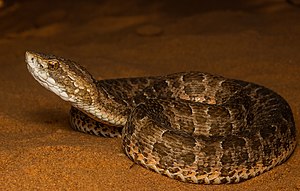São Paulo lance viper
| São Paulo lance viper | ||||||||||||
|---|---|---|---|---|---|---|---|---|---|---|---|---|

Sao Paulo lance viper ( Bothrops itapetiningae ) |
||||||||||||
| Systematics | ||||||||||||
|
||||||||||||
| Scientific name | ||||||||||||
| Bothrops itapetiningae | ||||||||||||
| ( Boulenger , 1907) |
The São Paulo Pitviper ( Bothrops itapetiningae ) is a viper from the subfamily of the pit vipers and belongs to the genus of American Terciopelos ( Bothrops ). The first description was made by the zoologist George Albert Boulenger in 1907.
features
The São Paulo lance viper reaches a total length of around 40 cm, rarely more than 50 cm. The head is angular, elongated, triangular in shape when viewed from above and clearly set off from the neck. The eye has a pupil that is vertically slit when exposed to light. The body has a reddish to reddish brown basic color with several rows of dark spots. In the front area, these spots can have a light border, while the edge of the spots fades towards the tail. The head has five dark brown spots on top. The first four shields of the upper lip and the shields of the lower lip are whitish. Behind the middle of the head there are light-edged stripes running towards the sides of the head. The ventral side is light and mottled gray-brown at the edges. As is typical for vipers, the venom apparatus consists of venom glands located on the side of the skull (specialized salivary glands ) and movable fangs located in the anterior upper jaw (solenoglyph tooth position).
Pholidosis
The pholidosis (scaling) shows the following characteristics:
- 8 upper lip shields ( supralabials ),
- 10 lower lip shields ( sublabials ),
- Snout shield ( Scutum rostrale ) higher than wide, lower edge wider than the upper edge,
- Nasal shield ( scutum nasale ) is undivided,
-
Scuta ocularia
- Upper eye shield (Scutum supraoculare) conspicuously large, i. d. R. surrounded by 7 smaller scales,
- 2 to 3 posterior shields (Scuta postocularia),
- 2 to 3 lower eye shields (scura subocularia), separated from the upper lip shields by a series of small scales,
- 25 to 27 rows of strongly keeled trunk scales ( Scuta dorsalia ),
- 144 to 160 abdominal shields ( Scuta ventralia ),
- 26 to 38 under tail shields ( Scuta subcaudalia ) and
- 1 undivided anal shield ( scutum anale ).
Systematics
On the basis of molecular biological studies, among other things , Fenwick et al. (2009) and Wallach et al. (2014) proposed a split of the genus Bothrops , whereby the São Paulo lance viper would be transferred to the genus Rhinocerophis under the name Rhinocerophis itapetiningae .
distribution
The distribution area includes areas of the regions Minas Gerais , Goiás , Mato Grosso , São Paulo , Parana , Santa Catarina and possibly Rio Grande do Sul within southeast Brazil . The populated biotopes are represented by savannahs, bushland and open fields.
Way of life
The São Paulo lance viper leads a ground-dwelling and largely nocturnal way of life. The prey spectrum includes primarily small mammals, lizards, frogs and small birds. The propagation is done by ovoviviparity , so egg-viviparous. A litter can contain six to ten juvenile snakes.
Snake venom
Poison bites from this species rarely occur. The danger of a poison bite is rated as less than that from some related species (e.g. Bothrops asper ), but intoxications must nevertheless be regarded as potentially life-threatening. The poison secretion of the São Paulo lance viper contains fibrinogenases . Furthermore, it probably contains cytotoxins , hemorrhagins ( blood vessel-damaging metalloproteases ) and myotoxins . Few clinical reports are available. Local swelling , blistering , necrosis , coagulopathy and bleeding are key symptoms of poisoning after a poison bite by the São Paulo lance viper . Various antivenins , such as 'Polyvalent Antivenom' (Instituto Clodomiro Picado, Costa Rica) or 'Soro antibotropico-laquetico' (Instituto Butantan, Brazil), are available for therapy.
Individual evidence
- ↑ a b Bothrops itapetiningae in The Reptile Database (accessed July 2, 2018)
- ↑ a b c University of Adelaide, Clinical Toxinology Resources: Bothrops itapetiningae (accessed July 2, 2018)
literature
- Ludwig Trutnau: Snakes in the Terrarium Vol. 2: Poisonous snakes . Verlag Ulmer, Stuttgart 1998, ISBN 3-8001-7052-3 .
